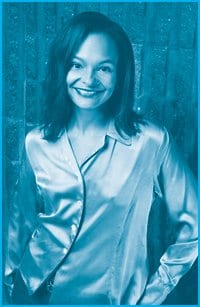“Write what you know” is one of those bits of free-floating wisdom aspiring writers inevitably run into.
Anyone who laughs, snorts and gasps their way through Venous Hum, Suzette Mayr’s very queer third novel, will be curious to discover precisely how closely she paid heed to that advice.
If she did take it to heart, her daily routine must take her well beyond bizarre (though in an inspired and madcap way).
Just consider her novel’s highlights: besides offering a relatively conventional mixture of heartache and infidelity-not to mention lust, laughter and gales of tears-Mayr’s story introduces a murderous retirement age ex-nurse, a cannibal’s feast (complete with a recipe for Deep-Fried Fingers in Black Bean Sauce), and a domineering grade school teacher who torments her defenceless pupils by literally sucking their blood.
And let’s not forget the pregnant married suburban lesbian having a half-hearted affair with her best friend’s vain pothead of a husband.
All this mayhem, incidentally, takes place in Calgary, a city normally associated with rodeos and the oil sector.
Speaking to Mayr in Calgary, where she was born and now teaches at the University of Calgary, it becomes clear that there’s intermittent overlap between her facts and her fiction.
Like Lai Fun Kugelheim, the sour, foul-mouthed and supremely irritated protagonist of Venous Hum, Mayr has stores of knowledge about suburban Calgary. Mayr is also biracial and the child of parents who immigrated to Canada during the Trudeau era (though she’s no hormone-crazed adulterer with axes to grind).
Yet unlike Lai Fun, Mayr was not named after a noodle. Nor is the self-described “quiet, unassuming and polite” writer pregnant, married (if only because it is illegal in her home province) or vegan (“I eat a lot of meat; I’m from Alberta!” she says).
What’s more, her time in high school was not the nightmare Lai Fun endured, and she has no direct experience with school reunions (“Although I went to a friend’s reunion to research the book and pretended to be his ex-wife.”)
She’s had no run-ins with cannibalism, apparitions or vampires, either.
“I’m fascinated by rule-breakers and with lawlessness,” the 36-year-old author states when probed about the origin of her novel’s hypnotic pageant of oddities-which includes Lai Fun’s cannibal mother Louve, dolorous lesbian sister Angelique, workaholic wife Jennifer Singh, frazzled best friend Stefanja Dumanowski (whose husband, Thor, she routinely beds), dead high school pal Kim Shisamoto and undead teacher Mrs Blake.
While the characters are a composite of real life and untrammelled imagination, they’re also a reflection of years of writing and revising. Over the past six years, Mayr says, the novel has changed radically: it began as a completely realistic tale of a high school reunion cast with heterosexual characters.
The lively, eccentric and metropolitan current version came as a result of Mayr’s reaching a creative cul de sac. “It was boring and bourgeois,” she explains, “I thought ‘So what? What’s the big deal, I’m rewriting something I’ve read 17 times before.’ There was nothing to add.”
Though she regrets that the “drawback to comic writing is that people don’t always take you seriously,” she can’t deny her affinity for comedy and eccentric plots. (The Widows, for instance, features elderly women taking a ride over Niagara Falls, and Moon Honey charts the path of a young woman who undergoes a transformation from being white-skinned to dark.)
That said, there’s also no missing that Venous Hum carefully melds mirthfulness with commentary about Alberta politics, the queer marriage debate and Canadian multiculturalism.
Mayr’s attention is drawn to the comic-a genre that mocks the endless human capacity for foolishness while celebrating our ability to change-in part because it is so fundamentally optimistic.
“You can only read so much Toni Morrison and Dionne Brand before you want to kill yourself,” she states, taking a moment to emphasize that she admires these writers in no uncertain terms. “But there’s a strong and lengthy tradition of the ‘tragic mulatto’ that suggests that all biracial lives are miserable and end in tragedy or death. That’s quite true of lesbians in literature as well. That’s not a story I want to keep telling. I’m writing against tradition in a number of ways, I guess.”
Mayr’s inspirations range from Jeanette Winterson to Canadian Prairie poet-iconoclasts Fred Wah and Robert Kroetsch. Despite those theory-savvy influences and her own position within academia, her writing is neither dry nor in-your-face cerebral. It’s bawdy, silly, rough at the edges and, above all, enjoyable and accessible in equal measure.
“Interest in popular culture comes naturally to me,” Mayr says. “Besides, I’m interested in the practical-how the theory is practiced. I have been ever since I got a receptionist job at a used car dealership when I was ‘the queen of feminist theory’ and had to actually deal with a sexist-pig boss. Now when I think of an issue I want to know, ‘What’s the implication on the street?'”
SUZETTE MAYR.
Venous Hum.
Reading with Larissa Lai.
Nov 7, 7 pm.
Honey Lounge, 455 Abbott St.

 Why you can trust Xtra
Why you can trust Xtra


